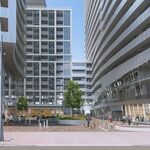steveintoronto
Superstar
YES! YES! YES!I'll bet that Toronto's suburban councillors will not allow this:
That is *exactly* what this is missing:

Dedicated two-stage southbound cyclist crossing at Queen and Soho
Whoever produced this render needs to be doored. First, this intersection is presently signalled. It should stay that way, with a *third phase signal* for cyclists to "enter the intersection from the side", as this is a jogged intersection, and to enter it *across the flow* is in violation of the HTA unless treated as multi-point intersection and signalled as such.
But in general, the signalling specifics needed above besides, the NYC example shown would address a huge number of potential conflicts at this and other intersections.
Toronto *just doesn't get* a lot of these concepts. I just rode the Bloor lanes to see if any further improvements had been made. It's worse than ever, and drivers and cyclists alike should all be wearing cowboy hats, it's like the wired west.
Edit to Add:
Here's the Youtube link for Lis' Sneckdown vid, so you can large screen and HD it:
"Daylighting"...I love it...
Last edited:











